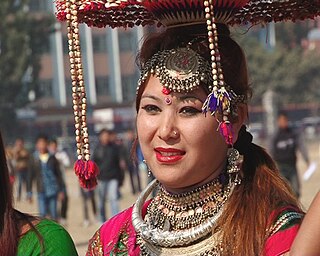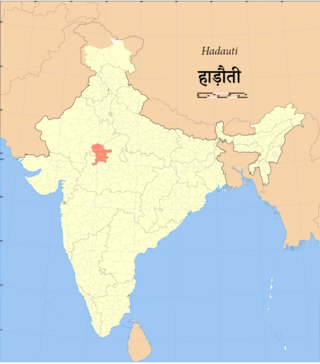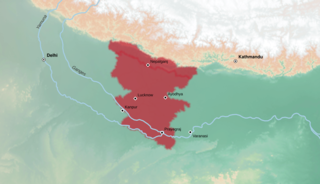Related Research Articles

The Indo-Aryan languages are a branch of the Indo-Iranian languages in the Indo-European language family. As of the early 21st century, they have more than 800 million speakers, primarily concentrated east of the Indus river in Bangladesh, India, Pakistan, Sri Lanka, Maldives and Nepal. Moreover, apart from the Indian subcontinent, large immigrant and expatriate Indo-Aryan–speaking communities live in Northwestern Europe, Western Asia, North America, the Caribbean, Southeast Africa, Polynesia and Australia, along with several million speakers of Romani languages primarily concentrated in Southeastern Europe. There are over 200 known Indo-Aryan languages.

Languages spoken in the Republic of India belong to several language families, the major ones being the Indo-Aryan languages spoken by 78.05% of Indians and the Dravidian languages spoken by 19.64% of Indians; both families together are sometimes known as Indic languages. Languages spoken by the remaining 2.31% of the population belong to the Austroasiatic, Sino–Tibetan, Tai–Kadai, and a few other minor language families and isolates. According to the People's Linguistic Survey of India, India has the second highest number of languages (780), after Papua New Guinea (840). Ethnologue lists a lower number of 456.
Bihari languages are a group of the Indo-Aryan languages. The Bihari languages are mainly spoken in the Indian states of Bihar, Jharkhand, Uttar Pradesh, and West Bengal, and also in Nepal. The most widely spoken languages of the Bihari group are Bhojpuri, Magahi and Maithili.

Marwari is a language within the Rajasthani language family of the Indo-Aryan languages. Marwari and its closely related varieties like Dhundhari, Shekhawati and Mewari form a part of the broader Marwari language family. It is spoken in the Indian state of Rajasthan, as well as the neighbouring states of Gujarat and Haryana, some adjacent areas in eastern parts of Pakistan, and some migrant communities in Nepal. There are two dozen varieties of Marwari. Marwari is also referred to as simply Rajasthani.

Magahi, also known as Magadhi, is a Indo-Aryan language spoken in Bihar, Jharkhand and West Bengal states of eastern India, and in the Terai of Nepal. Magadhi Prakrit was the ancestor of Magahi, from which the latter's name derives.

The Tharu people are an ethnic group indigenous to the Terai in southern Nepal and northern India. They speak Tharu languages. They are recognized as an official nationality by the Government of Nepal. In the Indian Terai, they live foremost in Uttarakhand, Uttar Pradesh and Bihar. The Government of India recognizes the Tharu people as a scheduled Indian tribe.

The Northern Indo-Aryan languages, also known as Pahāṛi languages, are a proposed group of Indo-Aryan languages spoken in the lower ranges of the Himalayas, from Nepal in the east, through the Indian states of Jammu and Kashmir, Uttarakhand, Himachal Pradesh and Punjab was coined by G. A. Grierson.

Hadauti or Harauti (Hadoti) is an Indo-Aryan language of Rajasthani languages group spoken by approximately four million people in the Hadoti region of southeastern Rajasthan, India. Its speakers are concentrated in the districts of Kota, Baran, Bundi and Jhalawar in Rajasthan, as well as in neighbouring areas of Madhya Pradesh.

Awadhi, also known as Audhi, is an Indo-Aryan language spoken in the Awadh region of Uttar Pradesh in northern India and in Terai region of western Nepal. The name Awadh is connected to Ayodhya, the ancient city, which is regarded as the homeland of the Hindu deity Rama, the earthly avatar of Vishnu. It was, along with Braj, used widely as a literary vehicle before gradually merging and contributing to the development of standardized Hindi in the 19th century. Though distinct from standard Hindi, it continues to be spoken today in its unique form in many districts of central Uttar Pradesh.

Rajasthani languages are a branch of Western Indo-Aryan languages. It is spoken primarily in Rajasthan and Malwa, and adjacent areas of Haryana, Gujarat and Madhya Pradesh in India. There are also speakers in the Pakistani provinces of Punjab and Sindh. Rajasthani is also spoken to a lesser extent in Nepal where it is spoken by 25,394 people according to the 2011 Census of Nepal.

Nagpuri is an Indo-Aryan language spoken in the Indian states of Jharkhand, Chhattisgarh, Odisha and Bihar. It is primarily spoken in the west and central Chota Nagpur plateau region. It is sometimes considered a dialect of Bhojpuri.

South Asia is home to several hundred languages, spanning the countries of Afghanistan, Bangladesh, Bhutan, India, Maldives, Nepal, Pakistan, and Sri Lanka. It is home to the third most spoken language in the world, Hindi–Urdu; and the sixth most spoken language, Bengali. The languages in the region mostly comprise Indo-Iranic and Dravidian languages, and further members of other language families like Austroasiatic, and Tibeto-Burman languages.

The Tharu or Tharuhat languages are any of the Indo-Aryan languages spoken by the Tharu people of the Terai region in Nepal, and neighboring regions of Uttarakhand, Uttar Pradesh and Bihar in India.

The Punjabi dialects and languages or Greater Punjabi are a series of dialects and languages spoken around the Punjab region of Pakistan and India with varying degrees of official recognition. They have sometimes been referred to as the Greater Punjabi macrolanguage. Punjabi may also be considered as a pluricentric language with more than one standard variety.

The Eastern Indo-Aryan languages, also known as Māgadhan languages, are spoken throughout the eastern region of the subcontinent, which includes Bihar, Uttar Pradesh, Jharkhand, Bengal region, Tripura, Assam, and Odisha; alongside other regions surrounding the northeastern Himalayan corridor. Bengali is official language of Bangladesh and the state of West Bengal, Tripura and the Barak valley of Assam while Assamese and Odia are the official languages of Assam and Odisha, respectively. The Eastern Indo-Aryan languages descend from Abahattha, which descends from Magadhan Apabhraṃśa and ultimately from Magadhi Prakrit.
Most of the languages of Bihar, the third most populous state of India, belong to the Bihari subgroup of the Indo-Aryan family. Chief among them are Bhojpuri, spoken in the west of the state, Maithili in the north, Magahi in center around capital Patna and in the south of the state. Maithili has official recognition under the Eighth Schedule to the Constitution of India. The official language of Bihar is Modern Standard Hindi, with Standard Urdu serving as a second official language in 15 districts.
Kochila Tharu, also called Morangiya, Septari or Saptariya Tharu, Madhya-Purbiya Tharu, and Mid-Eastern Tharu, is a diverse group of language varieties in the Tharu group of the Indo-Aryan languages. The several names of the varieties refer to the regions where they dominate. It is one of the largest subgroupings of Tharu. It is spoken mainly in Nepal with approximately 250,000 speakers as of 2003. In addition to language, cultural markers around attire and customs connect individuals into the ethnic identity Kochila.
Danguara Tharu also known as Dangauli Tharu, Dangora Tharu, or Dangura Tharu is one of the Tharu languages spoken by the Tharu people in the Dang, Kapilvastu, Banke, and Bardiya districts of the Lumbini Province and in Kailali and Kanchanpur district of Sudurpaschim Province of Nepal, primarily in the Western Terai Region as well as in Bahraich, Gorakhpur, and Lakhimpur Kheri districts of Uttar Pradesh in India.
Rana Tharu is a Indo Aryan language spoken by the Rana Tharu people who are part of the Tharu ethnic group in the Sudurpashchim Province of Nepal, specifically in the Kanchanpur district's southern municipalities and Dhangadhi in the Kailali district. Rana Tharu is also spoken in specific areas of Uttar Pradesh, India including the Lakhimpur Kheri district, particularly in Palia Kalan and Chandan Chauki block, situated on the India–Nepal border. Additionally, it is spoken in the Udham Singh Nagar district of Uttarakhand state. It exhibits high intelligibility among its dialects, with reported percentages ranging from 96% to 99%. The language has linguistic distinctions with dialects in India and shows lexical similarities with Awadhi and Buksa as well.
The Sonha language also known as Sonaha, Sunha, or Sunah is an Indo-Aryan language spoken by the Sonha people in Lumbini Province, specifically in Bardiya District, covering Geruwa and Rajapur municipalities. It is also spoken in Sudurpashchim Province, particularly in Kanchanpur District and Bhimdatta of Nepal. Sonha exhibits linguistic similarities with Awadhi, with reported lexical similarities of 69% with Rana Tharu, 73% with Kathariya Tharu, and 72% with Dangaura Tharu. Notably, Sonha and Kathoriya serve as a lexical bridge connecting Rana and Dangaura varieties of Tharu.
References
- ↑ Kathariya Tharu at Ethnologue (26th ed., 2023)

- ↑ "Copula Construction in Kathariya Tharu".
- 1 2 3 "Kathariya Tharu". Ethnologue. Retrieved December 25, 2023.
- 1 2 3 Boehm, Edward Daniel and Eichentopf, Stephanie and Mitchell, Jessica. 2012. A Sociolinguistic Study of Dangaura Tharu and Related Varieties. Central Department of Linguistics Tribhuvan University, Nepal and SIL International. vii+183pp.
- 1 2 3 Dan Raj Regmi. 2015. Exploring relationships among the major Indo-Aryan languages of Tarai in Nepal. Nepalese Linguistics 30. 122-131.